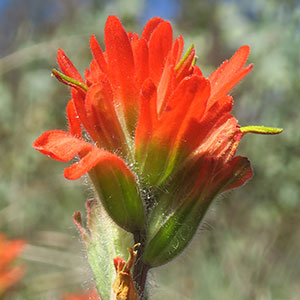Castilleja brevilobata
Castilleja subinclusa
short-lobed paintbrush
Franciscan paint brush, longleaf Indian paintbrush
solitary or few, erect or ascending, unbranched, sometimes branched, hairs spreading, short, medium, and long, soft, short and medium ones short stipitate-glandular.
solitary or few to many, erect to ascending, often leaning on nearby shrubs (var. jepsonii), unbranched or branched, often with small, leafy axillary shoots, hairs matted to spreading, short and long, soft, mixed with short stipitate-glandular ones.
green or ± yellow, lanceolate, elliptic, or oblong to narrowly ovate, 1–2(–2.5) cm, not fleshy, margins plane or wavy, involute, (0–)3–5(–7)-lobed, apex rounded to acute;
lobes ascending to erect, linear to lanceolate, apex rounded to acute.
green, pale gray-green, sometimes dull reddish purple, linear to narrowly, sometimes broadly, lanceolate, 2–10.5 cm, not fleshy, margins plane, sometimes ± wavy, flat or involute, 0(–3)-lobed, apex acuminate to acute;
lobes spreading, linear to short-lanceolate, often arising near mid length, apex acute to obtuse.
3–20 × 2–3.5 cm;
bracts proximally greenish to dull brown, distally red, orange-red, or scarlet, sometimes orange or yellow, broadly lanceolate or oblong, (0–)3–5-lobed;
lobes ascending, broadly to narrowly lanceolate, short, arising above mid length, apex acute, obtuse, or rounded.
3–30 × 1–7 cm;
bracts green or dull purple throughout, or proximally green or dull purple, distally bright red to orange-red, sometimes salmon, orange, or yellow, usually linear to lanceolate, distal sometimes broadly lanceolate to oblong or elliptic, 0(–3)-lobed;
lobes spreading to erect, linear to oblong or triangular, short or medium length, arising near or above mid length, apex acute to obtuse.
straight, 15–24(–26) mm;
tube 12–16 mm;
beak exserted, abaxial lip equal to calyx;
beak adaxially green or ± yellow-green, 7–10 mm, puberulent, stipitate-glandular;
abaxial lip deep green, reduced, rounded, 1–2 mm, 10–25% as long as beak;
teeth incurved to erect, light green, 0.5–1 mm.
curved proximally, straight to slightly curved distally, 25–57 mm;
tube 15–29 mm;
beak subequal to or exceeding calyx but abaxial lip, beak, and often part of tube usually exserted out abaxial cleft;
beak adaxially green, yellow-green, or yellow, 13–21 mm, margins red, orange, or yellow;
abaxial lip green, yellow, reddish, blackish, or deep red-purple, reduced, protuberant, forming a platform, 1–2 mm, 5–25% as long as beak;
teeth ascending, green, purple sometimes with reddish tip, yellow, or blackish, 0.5–1 mm.
green or whitish with green veins, lobes colored as bract lobes or paler, 14–30 mm;
abaxial and adaxial clefts 5.5–8.5 mm, 30–40% of calyx length, deeper than laterals, lateral 1.5–4 mm, 20–25% of calyx length;
lobes oblong to narrowly triangular, apex obtuse to rounded.
proximally pale green, rarely pale purple, distally bright red or red-orange, rarely orange or yellow, or bright red or red-orange throughout, 20–42 mm;
abaxial clefts 13–27 mm, adaxial 7–17 mm, abaxial 40–70% of calyx length, adaxial 12–33% of calyx length, deeper than laterals, lateral 0–7.5 mm, 0–35% of calyx length;
lobes linear to narrowly triangular, strongly curved away from stem proximally and distally obviously curved toward stem, apex acute to acuminate to obtuse.
= 24.
= 24, 48, 72, 96.
Castilleja brevilobata
Castilleja subinclusa
Castilleja brevilobata is endemic to dry serpentine openings in the Siskiyou Mountains of southwestern Oregon and adjacent California. Although sometimes treated as part of C. applegatei or C. hispida, its morphology does not suggest a close connection with either. This species occasionally hybridizes with C. pruinosa in Del Norte County, California.
(Discussion copyrighted by Flora of North America; reprinted with permission.)
Varieties 3 (3 in the flora).
Castilleja subinclusa is divided into three varieties with somewhat discontinuous ranges. Identification of the varieties is often difficult when comparing only a single trait but is more easily accomplished when the characters are considered in a suite. The three varieties are also separable by range and habitat.
(Discussion copyrighted by Flora of North America; reprinted with permission.)
1. Corolla beaks adaxially bright yellow, sometimes greenish yellow near apex, margins yellow, rarely orange or red, strongly contrasting with color of calyces; stems and leaves greenish, sometimes dull reddish; lateral calyx clefts 0–4 mm; coastal scrub communities; coastal c California. | var. franciscana |
1. Corolla beaks adaxially green to yellow-green, rarely yellow, margins red to orange, rarely yellow, not strongly contrasting with color of calyces; stems and leaves greenish, pale gray-green, or dull reddish; lateral calyx clefts 3–7.5 mm; dry, sandy or rocky slopes, desert scrub, foothill woodlands, chaparral, brushy openings in pine-oak woods; w foothills of Sierra Nevada in c California or sw California. | → 2 |
2. Stems and leaves greenish, sometimes dull reddish; bracts (0–)3-lobed; brushy openings in pine-oak woods; mostly in w foothills of Sierra Nevada in c California. | var. subinclusa |
2. Stems usually dull reddish; leaves usually pale gray-green to ± ash-colored; bracts 0(–3)-lobed; dry, sandy or rocky slopes, desert scrub, foothill woodlands, chaparral; sw California. | var. jepsonii |


